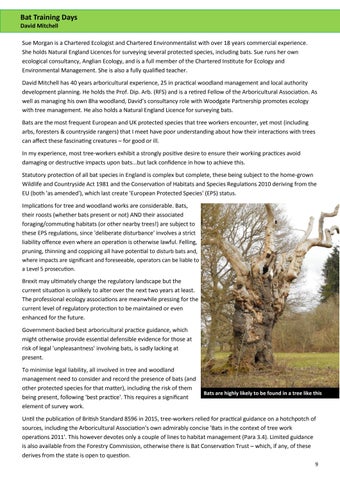Bat Training Days David Mitchell Sue Morgan is a Chartered Ecologist and Chartered Environmentalist with over 18 years commercial experience. She holds Natural England Licences for surveying several protected species, including bats. Sue runs her own ecological consultancy, Anglian Ecology, and is a full member of the Chartered Institute for Ecology and Environmental Management. She is also a fully qualified teacher. David Mitchell has 40 years arboricultural experience, 25 in practical woodland management and local authority development planning. He holds the Prof. Dip. Arb. (RFS) and is a retired Fellow of the Arboricultural Association. As well as managing his own 8ha woodland, David’s consultancy role with Woodgate Partnership promotes ecology with tree management. He also holds a Natural England Licence for surveying bats. Bats are the most frequent European and UK protected species that tree workers encounter, yet most (including arbs, foresters & countryside rangers) that I meet have poor understanding about how their interactions with trees can affect these fascinating creatures – for good or ill. In my experience, most tree-workers exhibit a strongly positive desire to ensure their working practices avoid damaging or destructive impacts upon bats...but lack confidence in how to achieve this. Statutory protection of all bat species in England is complex but complete, these being subject to the home-grown Wildlife and Countryside Act 1981 and the Conservation of Habitats and Species Regulations 2010 deriving from the EU (both 'as amended'), which last create 'European Protected Species' (EPS) status. Implications for tree and woodland works are considerable. Bats, their roosts (whether bats present or not) AND their associated foraging/commuting habitats (or other nearby trees!) are subject to these EPS regulations, since 'deliberate disturbance' involves a strict liability offence even where an operation is otherwise lawful. Felling, pruning, thinning and coppicing all have potential to disturb bats and, where impacts are significant and foreseeable, operators can be liable to a Level 5 prosecution. Brexit may ultimately change the regulatory landscape but the current situation is unlikely to alter over the next two years at least. The professional ecology associations are meanwhile pressing for the current level of regulatory protection to be maintained or even enhanced for the future. Government-backed best arboricultural practice guidance, which might otherwise provide essential defensible evidence for those at risk of legal 'unpleasantness' involving bats, is sadly lacking at present. To minimise legal liability, all involved in tree and woodland management need to consider and record the presence of bats (and other protected species for that matter), including the risk of them being present, following 'best practice'. This requires a significant element of survey work.
Bats are highly likely to be found in a tree like this
Until the publication of British Standard 8596 in 2015, tree-workers relied for practical guidance on a hotchpotch of sources, including the Arboricultural Association's own admirably concise 'Bats in the context of tree work operations 2011'. This however devotes only a couple of lines to habitat management (Para 3.4). Limited guidance is also available from the Forestry Commission, otherwise there is Bat Conservation Trust – which, if any, of these derives from the state is open to question. 9








